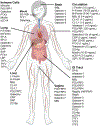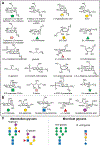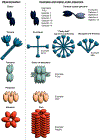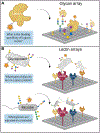Soluble Human Lectins at the Host-Microbe Interface
- PMID: 38640018
- PMCID: PMC11296910
- DOI: 10.1146/annurev-biochem-062917-012322
Soluble Human Lectins at the Host-Microbe Interface
Abstract
Human lectins are integral to maintaining microbial homeostasis on the skin, in the blood, and at mucosal barriers. These proteins can recognize microbial glycans and inform the host about its microbial status. In accordance with their roles, their production can vary with tissue type. They also can have unique structural and biochemical properties, and they can influence microbial colonization at sites proximal and distal to their tissue of origin. In line with their classification as innate immune proteins, soluble lectins have long been studied in the context of acute infectious disease, but only recently have we begun to appreciate their roles in maintaining commensal microbial communities (i.e., the human microbiota). This review provides an overview of soluble lectins that operate at host-microbe interfaces, their glycan recognition properties, and their roles in physiological and pathological mechanisms.
Keywords: glycans; inflammatory bowel disease; innate immunity; intelectin; lectins; microbiome.
Figures








Similar articles
-
Tools for investigating host-microbe crosstalk using glycan analysis probes inspired by human lectins.Glycobiology. 2025 Jun 2;35(7):cwaf031. doi: 10.1093/glycob/cwaf031. Glycobiology. 2025. PMID: 40421735
-
T-bet expressing Tr1 cells driven by dietary signals dominate the small intestinal immune landscape.bioRxiv [Preprint]. 2025 Jul 4:2025.06.30.662190. doi: 10.1101/2025.06.30.662190. bioRxiv. 2025. PMID: 40747421 Free PMC article. Preprint.
-
How lived experiences of illness trajectories, burdens of treatment, and social inequalities shape service user and caregiver participation in health and social care: a theory-informed qualitative evidence synthesis.Health Soc Care Deliv Res. 2025 Jun;13(24):1-120. doi: 10.3310/HGTQ8159. Health Soc Care Deliv Res. 2025. PMID: 40548558
-
The role of glycans in health and disease: Regulators of the interaction between gut microbiota and host immune system.Semin Immunol. 2024 May;73:101891. doi: 10.1016/j.smim.2024.101891. Epub 2024 Oct 10. Semin Immunol. 2024. PMID: 39388764 Review.
-
"I Don't Understand Their Sense of Belonging": Exploring How Nonbinary Autistic Adults Experience Gender.Autism Adulthood. 2024 Dec 2;6(4):462-473. doi: 10.1089/aut.2023.0071. eCollection 2024 Dec. Autism Adulthood. 2024. PMID: 40018066
Cited by
-
Intelectin-2 is a broad-spectrum antimicrobial lectin.bioRxiv [Preprint]. 2025 Jun 10:2025.06.09.658748. doi: 10.1101/2025.06.09.658748. bioRxiv. 2025. PMID: 40661551 Free PMC article. Preprint.
-
Tools for structural lectinomics: From structures to lectomes.BBA Adv. 2025 Mar 6;7:100154. doi: 10.1016/j.bbadva.2025.100154. eCollection 2025. BBA Adv. 2025. PMID: 40166736 Free PMC article.
-
Tools for investigating host-microbe crosstalk using glycan analysis probes inspired by human lectins.Glycobiology. 2025 Jun 2;35(7):cwaf031. doi: 10.1093/glycob/cwaf031. Glycobiology. 2025. PMID: 40421735
References
-
- HumanLectome - A database of all the human lectins. https://unilectin.unige.ch
Publication types
MeSH terms
Substances
Grants and funding
LinkOut - more resources
Full Text Sources

